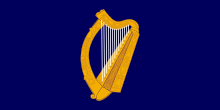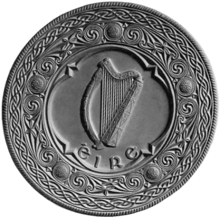President of Ireland
| President of Ireland
Uachtarán na hÉireann (Irish) | |
|---|---|
|
| |
|
| |
| Style |
President (Uachtarán) or Your Excellency (A Shoilse) |
| Residence | Áras an Uachtaráin |
| Seat | Dublin |
| Term length |
Seven years (renewable once) |
| Inaugural holder | Douglas Hyde |
| Formation | 25 June 1938 |
| Salary | €250,000[1] |
| Website |
www |
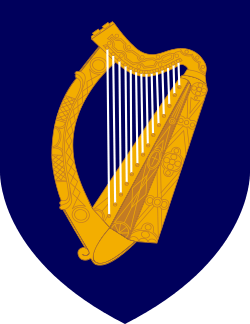 |
| This article is part of a series on the politics and government of the Republic of Ireland |
|
Judiciary |
|
Administrative geography |
The President of Ireland (Irish: Uachtarán na hÉireann, /ˈuəxtərɑːn nə hˈɛərən/) is the head of state of Ireland and the Supreme Commander of the Irish Defence Forces.
The President holds office for seven years, and can be elected for a maximum of two terms.[2] Unless a candidate runs unopposed, the President is directly elected by the people. The presidency is largely a ceremonial office, but the President does exercise certain limited powers with absolute discretion. The President acts as a representative of the Irish state. Former President Mary McAleese described the office as 'the guardian of the constitution'. The President's official residence is Áras an Uachtaráin, which is located in the Phoenix Park in Dublin. The office was established by the Constitution of Ireland in 1937, and became internationally recognised as head of state in 1949 following the coming into force of the Republic of Ireland Act.
The current president is His Excellency Michael D Higgins, who was elected on 29 October 2011. His inauguration was held on 11 November 2011. President Higgins is a veteran left-wing politician and human rights campaigner. As a member of the Labour Party, he has served in both houses of the Oireachtas. President Higgins is also a poet and speaks the Irish language fluently.
Ordinary duties and functions
The Constitution of Ireland provides for a parliamentary system of government, under which the role of the head of state is largely a ceremonial one. The President is formally one of three parts of the Oireachtas (national parliament), which also comprises Dáil Éireann (the lower house) and Seanad Éireann (the Senate or upper house).
Unlike most other parliamentary democracies, the President is not even the nominal chief executive. Rather, executive authority is expressly vested in the Government (cabinet). The Government is obliged, however, to keep the President generally informed on matters of domestic and foreign policy. Most of the functions of the President may be carried out only in accordance with the strict instructions of the Constitution, or the binding 'advice' of the Government. The President does, however, possess certain personal powers that may be exercised at his or her discretion.
Constitutional functions
The main functions are prescribed by the Constitution:
- Appoints the government
- The President formally appoints the Taoiseach (head of government) and other ministers, and accepts their resignations. The Taoiseach is appointed upon the nomination of the Dáil, and the President is required to appoint whomever the Dáil designates without the right to decline appointment. The remainder of the cabinet is appointed upon the nomination of the Taoiseach and approval of the Dáil; as with appointing the Taoiseach, the President is required to make the appointment without the right to appoint someone else. Ministers are dismissed on the advice of the Taoiseach and the Taoiseach must, unless there is a dissolution of the Dáil, resign upon losing the confidence of the house.
- Appoints the judiciary
- The President appoints the judges to all Courts of the Republic of Ireland, on the advice of the Government.[3]
- Convenes and dissolves the Dáil
- This power is exercised on the advice of the Taoiseach; government or Dáil approval is not needed. The President may only refuse a dissolution when a Taoiseach has lost the confidence of the Dáil.[3]
- Signs bills into law
- The President cannot veto a bill that the Dáil and the Seanad have adopted. However, he/she may refer it to the Supreme Court to test its constitutionality. If the Supreme Court upholds the bill, the President must sign it. If, however, it is found to be unconstitutional, the President will decline to give assent.[3]
- Represents the state in foreign affairs
- [3] This power is exercised only on the advice of the Government. The President accredits ambassadors and receives the letters of credence of foreign diplomats. Ministers sign international treaties in the President's name. This role was not exercised by the President prior to the Republic of Ireland Act 1948
- Supreme Commander of the Defence Forces
- [4] This role is somewhat similar in statute to that of a commander-in-chief. An officer's commission is signed and sealed by the President. This is a nominal position, the powers of which are exercised on the advice of the Government. (See Minister for Defence.)
- Power of pardon
- The President, on the advice of the Government, has "the right of pardon and the power to commute or remit punishment".[5] Pardon, for miscarriages of justice, has applied rarely: Thomas Quinn in 1940, Brady in 1943, and Nicky Kelly in 1992.[6] The current procedure is specified by Section 7 of the Criminal Procedure Act, 1993.[7] There were plans in 2005 for paramilitary "on the runs" to receive pardons as part of the Northern Ireland peace process, to supplement the 1998 early release of serving prisoners after the Good Friday Agreement.[8] This was controversial and was soon abandoned along with similar British proposals.[9][10][11] Power of commutation and remittance are not restricted to the President,[12] though this was the case for death sentences handed down prior to the abolition of capital punishment.[13]
Other functions specified by statute or otherwise include:
- The President is ex officio President of the Irish Red Cross Society.[14]
- The President appoints, on the advice of the Government, the Senior Professors and chairman of the council of the Dublin Institute for Advanced Studies;[15] the governor of the Central Bank of Ireland;[16] the members of the Irish Financial Services Appeals Tribunal;[17] the Ombudsman;[18] and the members of the Garda Síochána Ombudsman Commission.[19]
- The President appoints one trustee to the Chester Beatty Library. This was specified in Chester Beatty's will and given effect by a 1968 Act of the Oireachtas.[20]
- The President is the patron of Gaisce – The President's Award, established by trust deed in 1985.[21]
- The President is the patron of Clans of Ireland, including its Order of Merit, since he so agreed in January 2012[22]
- The President confers the title of Saoi on those so elected by the membership of Aosdána.
- The President is patron to several charities in Ireland.
Special limitations
- The President may not leave the state without the consent of the Government.[23]
- Every formal address or message "to the nation" or to either or both Houses of the Oireachtas must have prior approval of the Government.[24] Other than on these two (quite rare) occasions, there is no limitation on the President's right to speak. While earlier presidents were exceptionally cautious in delivering speeches and on almost every occasion submitted them for vetting, Mary Robinson and Mary McAleese made much more use of their right to speak without government approval, with McAleese doing many live television and radio interviews. Nonetheless, by convention Presidents refrain from direct criticism of the Government.
Discretionary powers
The President possesses the following powers exercised "in his absolute discretion" according to the English version of the Constitution. The Irish version states that these powers are exercised as a chomhairle féin which is usually translated as "under his own counsel." In the event of a clash between the Irish and English versions of the constitution, the Irish one is given supremacy. Lawyers have suggested that a clash may exist in this case between both versions of the constitution. While "absolute discretion" appears to leave some freedom for manoeuvre for a president in deciding whether to initiate contact with the opposition, "own counsel" has been interpreted by some lawyers as suggesting that no contact whatsoever can take place. As a result of this clash, it is considered controversial for the president to be contacted by the leaders of any political parties in an effort to influence a decision made using the discretionary powers. It is required that, before exercising certain reserve powers, the President consult the Council of State. However, the President is not compelled to act in accordance with the council's advice.
Refusal of a Dáil dissolution
The Taoiseach is required to resign if he has "ceased to retain the support of a majority" of the Dáil, unless he asks the President to dissolve the Dáil. The President has the right to refuse such a request, in which case the Taoiseach must resign immediately. This power has never been invoked. However, the necessary circumstances existed in 1944, 1982 and 1994. The apparent discrepancy, referred to above, between the Irish and English versions of the Constitution has discouraged Presidents from contemplating the use of the power. On the three occasions when the necessary circumstances existed, presidents have adopted an ultra-strict application of a policy of non-contact with the opposition. The most notable instance of this was in January 1982, when Patrick Hillery instructed an aide, Captain Anthony Barber, to ensure that no telephone calls from the opposition were to be passed on to him. (Nevertheless, three opposition figures, including Fianna Fáil leader Charles Haughey, demanded to be put through to Hillery, with Haughey threatening to end Barber's career if the calls weren't put through. Hillery, as Supreme Commander of the Defence Forces, recorded the threat in Barber's file and recorded that Barber had been acting on his instructions in refusing the call[25]). Even without this consideration, refusing such a request would arguably create a constitutional crisis, as it is considered a fairly strong constitutional convention that the head of state always grants a parliamentary dissolution.
Reference of bills to the people
If requested to do so by a petition signed by a majority of the membership of the Seanad, and one-third of the membership of the Dáil, the President may, after consultation with the Council of State, decline to sign into law a bill (other than a bill to amend the constitution) he/she considers to be of great "national importance" until it has been approved by either the people in a referendum or the Dáil reassembling after a general election, held within eighteen months. This power has never been used, and no such petition has been invoked. Of the 60 Senators, 11 are nominated by the Taoiseach, so there is rarely a majority opposed to a government bill.
Other
The President may appoint up to seven members of the Council of State, and remove or replace such appointed members. (See list of presidential appointees to the Council of State.) The following powers all require prior consultation with the Council of State, although the President need not take its advice:
- Referral of bills to the Supreme Court
- The President may refer a bill, in whole or part, to the Supreme Court to test its constitutionality. If the Supreme Court finds any referred part unconstitutional, the entire bill falls. This power may not be applied to a money bill, a bill to amend the Constitution, or an urgent bill the time for the consideration of which has been abridged in the Seanad. This is the most widely used reserve power;[26] a full list is at Council of State (Ireland)#Referring of bills. In a 1982 judgment delivered under such a referral, Chief Justice Tom O'Higgins bemoaned the crude strictures of the prescribed process; especially the fact that, if the court finds that a bill does not violate the Constitution, this judgment can never subsequently be challenged.[27]
- Abridgement of the time for bills in the Seanad
- The President may, at the request of the Dáil, impose a time-limit on the period during which the Seanad may consider a bill. The effect of this power is to restrict the power of the Seanad to delay a bill that the Government considers urgent.
- Appointment of a Committee of Privileges
- The President may, if requested to do so by the Seanad, establish a Committee of Privileges to solve a dispute between the two Houses of the Oireachtas as to whether or not a bill is a money bill.[28]
- Address to the Oireachtas
- The President may address, or send a message to, either or both Houses of the Oireachtas. Four such addresses have been made: one by de Valera, two by Robinson, and one by McAleese.[26] The approval of the government is needed for the message; in practice, the entire text is submitted.[29]
- Address to the Nation
- The President may "address a message to the Nation" subject to the same conditions as an address to the Oireachtas. This power has never been used.[26] Commonplace messages, such as Christmas greetings, are not considered to qualify.[29]
- Convention of meetings of the Oireachtas
- The President may convene a meeting of either or both Houses of the Oireachtas. This power would allow the President to step in if, in extraordinary circumstances, the ordinary procedures for convening the houses had broken down.
Selection
The President is directly elected by secret ballot using the Alternative Vote, the single-winner analogue of the Single Transferable Vote.[n 1] Under the Presidential Elections Act, 1993 a candidate's election formally takes place in the form of a 'declaration' by the returning officer.[30] Where more than one candidate is nominated, the election is 'adjourned' so that a ballot can take place, allowing the electors to choose between candidates. A Presidential election is held in time for the winner to take office the day after the end of the incumbent's seven-year term. In the event of premature vacancy, an election must be held within sixty days.[2]
Only resident Irish citizens aged eighteen or more may vote; a 1983 bill to extend the right to resident British citizens was ruled unconstitutional.[31]
Candidates must be Irish citizens and over 35 years old.[32][33] However, there is a discrepancy between the English- and Irish-language texts of Article 12.4.1°. According to the English text, an eligible candidate "has reached his thirty-fifth year of age", whereas the Irish text has this as "ag a bhfuil cúig bliana tríochad slán" ("has completed his thirty-five years"). Because a person's thirty-fifth year of life begins on his or her thirty-fourth birthday, this means there is a year's difference between the minimum ages as stated in the two texts. Various proposals have been made to amend the Constitution so as to eliminate this discrepancy.[34] At present, however, the Irish version of the subsection prevails in accordance with the rule stated in Article 25.5.4°. The current government has introduced the Thirty-fifth Amendment of the Constitution (Age of Eligibility for Election to the Office of President) Bill 2015 to reduce the age of candidacy from 35 to 21, which was put to referendum in May 2015,[35][36] but the bill was heavily defeated, with approximately 73% of voters voting against reducing the age of eligibility.
Presidents can serve a maximum of two terms, consecutive or otherwise.[3] They must be nominated by one of the following:[3]
- At least 20 members of the Oireachtas;[33] (there are 226 members)
- At least four county or city councils[33] (there are 34 councils)
- Themselves (in the case of incumbent or former presidents who have served one term).[33]
Where only one candidate is nominated, he or she is deemed elected without the need for a ballot.[33] For this reason, where there is a consensus among political parties not to have a contest, the President may be 'elected' without the occurrence of an actual ballot. Since the establishment of the office this has occurred on six occasions.
The most recent presidential election was held on 27 October 2011.
Absence of a President
There is no office of Vice President of Ireland. In the event of a premature vacancy a successor must be elected within sixty days. In a vacancy or where the President is unavailable, the duties and functions of the office are carried out by a Presidential Commission, consisting of the Chief Justice, the Ceann Comhairle (speaker) of the Dáil, and the Cathaoirleach (chairperson) of the Seanad. Routine functions, such as signing uncontentious bills into law, have often been fulfilled by the Presidential Commission when the President is abroad on a state visit. The government's power to prevent the President leaving the state is relevant in aligning the diplomatic and legislative calendars.
Technically each president's term of office expires at midnight on the day before the new president's inauguration.[37] Therefore, between midnight and the inauguration the following day the presidential duties and functions are carried out by the Presidential Commission. The constitution also empowers the Council of State, acting by a majority of its members, to "make such provision as to them may seem meet" for the exercise of the duties of the president in any contingency the constitution does not foresee. However, to date, it has never been necessary for the council to take up this role.
Vacancies in the presidency have occurred three times: on the death of Erskine Hamilton Childers in 1974, and on the resignations of Cearbhall Ó Dálaigh in 1976 and Mary Robinson in 1997.
Official residence, salute, style and address
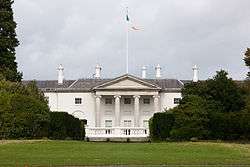
The official residence of the President is Áras an Uachtaráin, located in the Phoenix Park in Dublin. The ninety-two room building formerly served as the 'out-of-season' residence of the Irish Lord Lieutenant and the residence of two of the three Irish Governors-General: Tim Healy and James McNeill. The President is normally referred to as 'President' or 'Uachtarán', rather than 'Mr/Madam President' or similar forms. The style used is normally His Excellency/Her Excellency (Irish: A Shoilse/A Soilse); sometimes people may orally address the President as 'Your Excellency' (Irish: A Shoilse [ə ˈhəʎʃ̪ʲə]), or simply 'President' (Irish: A Uachtaráin [ə ˈuːəxt̪ˠəɾaːn̥] (vocative case)). The Presidential Salute is taken from the National Anthem, "Amhrán na bhFiann". It consists of the first four bars followed by the last five,[38] without lyrics.
Inauguration
Under the Constitution, in assuming office the President must subscribe to a formal declaration, made publicly and in the presence of members of both Houses of the Oireachtas, judges of the Supreme Court and the High Court, and other "public personages".[39] The inauguration of the President takes place in St Patrick's Hall in Dublin Castle. The declaration is specified in Article 12.8:
- I láthair Dia na nUilechumhacht, táimse, [ainm], á ghealladh agus á dhearbhú go sollúnta is go fírinneach bheith i mo thaca agus i mo dhídin do Bhunreacht Éireann, agus a dlíthe a chaomhnú, mo dhualgais a chomhlíonadh go dílis coinsiasach de réir an Bhunreachta is an dlí, agus mo lándícheall a dhéanamh ar son leasa is fónaimh mhuintir na hÉireann. Dia do mo stiúradh agus do mo chumhdach.[39]
- In the presence of Almighty God, I, [name], do solemnly and sincerely promise and declare that I will maintain the Constitution of Ireland and uphold its laws, that I will fulfil my duties faithfully and conscientiously in accordance with the Constitution and the law, and that I will dedicate my abilities to the service and the welfare of the people of Ireland. May God direct and sustain me.[39]
To date every President has subscribed to the declaration in Irish. In 1993 the United Nations Human Rights Committee expressed concern that, because of its religious language, the declaration amounts to a religious test for office. The Oireachtas Committee in 1998 recommended that the religious references be made optional.
Impeachment and removal from office
The President can be removed from office in two ways, neither of which has ever been invoked. The Supreme Court, in a sitting of at least five judges, may find the President "permanently incapacitated",[2] while the Oireachtas may remove the President for "stated misbehaviour".[40] Either house of the Oireachtas may instigate the latter process by passing an impeachment resolution, provided at least thirty members move it and at least two thirds support it. The other house will then either investigate the stated charges or commission a body to do so; following which at least two thirds of members must agree both that the President is guilty and that the charges warrant removal.[40]
Security and transport

As head of state of Ireland, the President receives the highest level of protection in the state. Áras an Uachtaráin is protected by armed guards from the Garda Síochána and Defence Forces at all times, and is encircled by security fencing and intrusion detection systems. At all times the President travels with an armed security detail in Ireland and overseas, which is provided by the Special Detective Unit (SDU), an elite wing of the Irish police force. Protection is increased if there is a known threat. The Presidential limousine is a Mercedes-Benz S-Class LWB. The Presidential Limousine is dark navy blue and carries the Presidential standard on the left front wing and the tricolour on the right front wing. When travelling the Presidential limousine is always accompanied by support cars (normally BMW 5 Series, Audi A6 and Volvo S60 driven by trained drivers from the SDU) and several Garda motorcycle outriders from the Garda Traffic Corps which form a protective convoy around the car.
The Presidential State Car is a 1947 Rolls-Royce Silver Wraith landaulette, which is used only for ceremonial occasions.
The President also has the full use of all Irish Air Corps aircraft at his/her disposal if so needed, including helicopters and private jets.
History
The office of President was established in 1937, in part as a replacement for the office of Governor-General that existed during the 1922–37 Irish Free State. The seven-year term of office of the President was inspired by that of the presidents of Weimar Germany. At the time the office was established critics warned that the post might lead to the emergence of a dictatorship. However, these fears were not borne out as successive Presidents played a limited, largely apolitical role in national affairs.
Head of state from 1937 to 1949
During the period of 1937 to 1949 it was unclear whether the Irish head of state was actually the President of Ireland or George VI, the king of Ireland. This period of confusion ended in 1949 when the state was declared to be a republic. The 1937 constitution did not mention the king; but, nor did it state that the president was head of state, saying rather that the president "shall take precedence over all other persons in the State". The president exercised some powers that could be exercised by heads of state, but, which could also be exercised by governors or governors-general, such as appointing the government and promulgating the law.
However, in 1936, George VI had been declared "King of Ireland" and, under the External Relations Act of the same year, it was this king who represented the state in its foreign affairs. Treaties, therefore, were signed in the name of the King of Ireland, who also accredited ambassadors and received the letters of credence of foreign diplomats. This role meant, in any case, that George VI was the Irish head of state in the eyes of foreign nations. The Republic of Ireland Act 1948, which came into force in April 1949, proclaimed a republic and transferred the role of representing the state abroad from the monarch to the president. No change was made to the constitution.
Evolving role
After the inaugural presidency of Douglas Hyde, who was an interparty nominee for the office, the nominees of the Fianna Fáil political party won every presidential election until 1990. The party traditionally used the nomination as a reward for its most senior and prominent members, such as party founder and longtime Taoiseach Éamon de Valera and European Commissioner Patrick Hillery. Most of its occupants to that time followed Hyde's precedent-setting conception of the presidency as a conservative, low-key institution that used its ceremonial prestige and few discretionary powers sparingly. In fact, the presidency was such a quiet position that Irish politicians sought to avoid contested presidential elections as often as possible, feeling that the attention such elections would bring to the office was an unnecessary distraction,[41] and office-seekers facing economic austerity would often suggest the elimination of the office as a money-saving measure.[42]
Despite the historical meekness of the presidency, however, it has been at the centre of some high-profile controversies. In particular, the fifth President, Cearbhall Ó Dálaigh, faced a contentious dispute with the government in 1976 over the signing of a bill declaring a state of emergency, which ended in Ó Dálaigh's resignation. His successor, Patrick Hillery, was also involved in a controversy in 1982, when then Taoiseach Garret FitzGerald requested a dissolution of the Dáil Éireann. Hillery was bombarded with phone calls from opposition members urging him to refuse the request, an action that Hillery saw as highly inappropriate interference with the President's constitutional role and resisted the political pressure.
The presidency began to be transformed in the 1990s. Hillery's conduct regarding the dissolution affair in 1982 came to light in 1990, imbuing the office with a new sense of dignity and stability. However, it was Hillery's successor, seventh President Mary Robinson, who ultimately revolutionized the presidency. The winner of an upset victory in the highly controversial election of 1990, Robinson was the Labour nominee, the first President to defeat Fianna Fáil in an election and the first female President. Upon election, however, Robinson took steps to de-politicize the office. She also sought to widen the scope of the presidency, developing new economic, political and cultural links between the state and other countries and cultures, especially those of the Irish diaspora. Robinson used the prestige of the office to activist ends, placing emphasis during her presidency on the needs of developing countries, linking the history of the Great Irish Famine to today's nutrition, poverty and policy issues, attempting to create a bridge of partnership between developed and developing countries.[42]
Issues of controversy
Role of the President in relation to Northern Ireland
The text of the Constitution of Ireland, as originally enacted in 1937, made reference in its controversial Articles 2 and 3 to two geopolitical entities: a thirty-two county 'national territory' (i.e., the island of Ireland), and a twenty-six county 'state' formerly known as the Irish Free State. The implication behind the title 'President of Ireland' was that the President would function as the head of all Ireland. However, this implication was challenged by the Ulster Unionists and the United Kingdom of Great Britain and Northern Ireland which was the state internationally acknowledged as having jurisdiction over Northern Ireland. Articles 2 and 3 were substantially amended in consequence of the 1998 Good Friday Agreement.
Ireland in turn challenged the proclamation in the United Kingdom of Queen Elizabeth II in 1952 as '[Queen] of the United Kingdom of Great Britain and Northern Ireland'. The Irish government refused to attend royal functions as a result; for example, Patrick Hillery declined on Government advice to attend the wedding of the Prince of Wales to Lady Diana Spencer in 1981, to which he had been invited by Queen Elizabeth, just as Seán T. O'Kelly had declined on government advice to attend the 1953 Coronation Garden Party at the British Embassy in Dublin. Britain in turn insisted on referring to the President as 'President of the Republic of Ireland' or 'President of the Irish Republic'.[n 2] Letters of Credence from Queen Elizabeth, on the British government's advice, appointing United Kingdom ambassadors to Ireland were not addressed to the 'President of Ireland' but to the President personally (for example: 'President Hillery').
The naming dispute and consequent avoidance of contact at head of state level has gradually thawed since 1990. President Robinson (1990–97) chose unilaterally to break the taboo by regularly visiting the United Kingdom for public functions, frequently in connection with Anglo-Irish Relations or to visit the Irish emigrant community in Great Britain. In another breaking of precedent, she accepted an invitation to Buckingham Palace by Queen Elizabeth II. Palace accreditation supplied to journalists referred to the "visit of the President of Ireland". Between 1990 and 2010, both Robinson and her successor President McAleese (1997–2011) visited the Palace on numerous occasions, while senior British Royals - The Prince of Wales, The Duke of York, The Earl of Wessex and The Duke of Edinburgh - all visited both Presidents of Ireland at Áras an Uachtaráin. The Presidents also attended functions with The Princess Royal. President Robinson jointly hosted a reception with the Queen at St. James's Palace, London, in 1995, to commemorate the one hundred and fiftieth anniversary of the foundation of the Queen's Colleges in 1845 (the Queen's Colleges are now known as The Queen's University of Belfast, University College, Cork, and National University of Ireland, Galway). These contacts eventually led to a state visit of Queen Elizabeth to the Republic of Ireland in 2011.
Though the President's title implicitly asserted authority in Northern Ireland, in reality the Irish President needed government permission to visit there. (The Constitution of Ireland in Article 3 explicitly stated that "[p]ending the re-integration of the national territory" the authority of the Irish state did not extend to Northern Ireland. Presidents prior to the presidency of Mary Robinson were regularly refused permission by the Irish government to visit Northern Ireland.)
However, since the 1990s and in particular since the Good Friday Agreement of 1998, the president has regularly visited Northern Ireland. President McAleese, who is herself the first President of Ireland to have been born in Northern Ireland, continued on from President Robinson in this regard. In a sign of the warmth of modern British-Irish relations, she has even been warmly welcomed by most leading unionists. At the funeral for a child murdered by the Real IRA in Omagh she symbolically walked up the main aisle of the church hand-in-hand with the Ulster Unionist Party leader and then First Minister of Northern Ireland, David Trimble, MP. But in other instances, Mary McAleese has been criticised for certain comments, such as a reference to the way in which Protestant children in Northern Ireland had been brought up to hate Catholics just as German children had been encouraged to hate Jews under the Nazi regime, on 27 January 2005, following her attendance at the ceremony commemorating the sixtieth anniversary of the liberation of Auschwitz concentration camp.[43][44] These remarks caused outrage among Northern Ireland's unionist politicians, and McAleese later apologised[45] and conceded that her statement had been unbalanced. Despite the changes to Articles 2 and 3 of the Constitution as part of the Good Friday Agreement the title of the office remains the "President of Ireland", as the Irish Constitution stipulates that the state's official name is simply "Ireland", and that the "Republic of" is merely its description, though there is now little dispute that the Presidency only has jurisdiction over the "Republic of" Ireland. However, the President of Ireland is regarded by many northern nationalists as their President, and calls have been made for voting rights in Presidential elections to be extended to the whole island.
Suggestions for reform
There have been many suggestions for reforming the office of President over the years. In 1996, the Constitutional Review Group recommended that the office of President should remain largely unchanged. However, it suggested that the Constitution should be amended to explicitly declare the President to be head of state (at present that term does not appear in the text), and that consideration be given to the introduction of a constructive vote of no confidence system in the Dáil, along the lines of that in Germany. If this system were introduced then the power of the President to refuse a Dáil dissolution would be largely redundant and could be taken away. The All-party Oireachtas Committee on the Constitution's 1998 Report made similar recommendations.
In an October 2009 poll, concerning support for various potential candidates in the 2011 presidential election conducted by the Sunday Independent, a "significant number" of people were said to feel that the presidency is a waste of money and should be abolished.[46]
List of Presidents of Ireland
The functions of the President were exercised by the Presidential Commission from the coming into force of the Constitution on 29 December 1937 until the election of Douglas Hyde in 1938, and during the vacancies of 1974, 1976, and 1997.
| No. | Name (Birth–Death) |
Portrait | Term of office | Nominated by | Election | ||
|---|---|---|---|---|---|---|---|
| 1. | Douglas Hyde (1860–1949) |
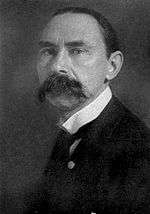 |
25 June 1938 | 24 June 1945 | All-party nomination | 1938 | |
| 2. | Seán T. O'Kelly (1882–1966) |
 |
25 June 1945 | 24 June 1959 | Fianna Fáil | 1945 | |
| Himself[n 3] | 1952 | ||||||
| 3. | Éamon de Valera (1882–1975) |
 |
25 June 1959 | 24 June 1973 | Fianna Fáil | 1959 | |
| Fianna Fáil[n 4] | 1966 | ||||||
| 4. | Erskine H. Childers (1905–1974) |
25 June 1973 | 17 November 1974 | Fianna Fáil | 1973 | ||
| 5. | Cearbhall Ó Dálaigh[47] (1911–1978) |
19 December 1974 | 22 October 1976 | All-party nomination | 1974 | ||
| 6. | Patrick Hillery (1923–2008) |
.jpg) |
3 December 1976 | 2 December 1990 | Fianna Fáil | 1976 | |
| Fianna Fáil | 1983 | ||||||
| 7. | Mary Robinson (1944–) |
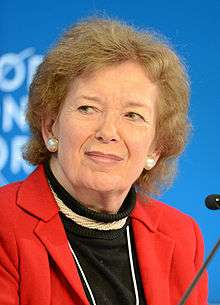 |
3 December 1990 | 12 September 1997 | Labour Party | 1990 | |
| Workers' Party | |||||||
| Independents | |||||||
| 8. | Mary McAleese (1951–) |
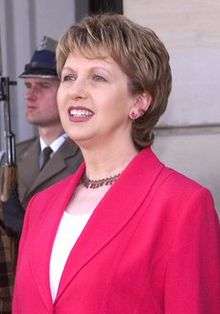 |
11 November 1997 | 10 November 2011 | Fianna Fáil | 1997 | |
| Herself | 2004 | ||||||
| 9. | Michael D. Higgins (1941–) |
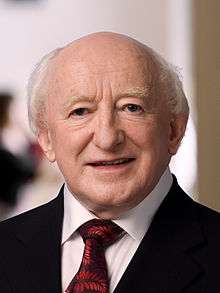 |
11 November 2011 | Incumbent | Labour Party | 2011 | |
Former Presidents
Currently, there are two living former presidents. They are:
- Mary Robinson
- Mary McAleese
Former presidents who are willing and able to serve are members of the Council of State.[48]
Statistics
- Douglas Hyde became president when he was 78; the oldest person to take office.
- Éamon de Valera was the oldest president to leave office, aged 90.
- Mary Robinson was the youngest president to take office when she was inaugurated, aged 46, and she was the youngest to leave office, aged 53. Her successor Mary McAleese, also 46 when inaugurated, was 58 days younger than Robinson, becoming the youngest president.
- Erskine Childers, who died in office, had the shortest presidency of 511 days.
- Cearbhall Ó Dálaigh, who resigned, served for 674 days.
- Four presidents have served for two terms, or fourteen years in total: Seán T. O'Kelly, Éamon De Valera, Patrick Hillery, and Mary McAleese.
See also
- President of the Irish Republic
- Gaisce – The President's Award
- Seal of the President of Ireland
- Presidential Standard of Ireland
- Secretary-General to the President
- Warrant of Appointment
Notes
- ↑ While Article 12.2.3° specifies "proportional representation by means of the single transferable vote", the Constitution Review Group and the All-Party Oireachtas Committee both recommend deleting "proportional representation", which does not apply to a single-winner election.
- ↑ The office of "President of the Irish Republic" existed in the separatist Irish Republic of 1919–21.
- ↑ In 1952 Seán T. O'Kelly re-nominated himself, as was his right under the Constitution. This allowed him a free run, as he was not the nominee of a specific party, and the other parties could let him be re-elected unopposed without loss of face.
- ↑ Unlike Seán T. O'Kelly in 1952, De Valera was renominated in 1966 by Fianna Fáil. As a result Fine Gael felt honour bound to nominate a candidate, albeit low key. In the event their candidate, Tom O'Higgins, came within 1% (or 10,000 votes) of winning.
References
- ↑ "Higher or lower: how does Michael D's new salary compare to other heads of state?". TheJournal.ie. 10 November 2011.
- 1 2 3 Constitution of Ireland: Article 12.3
- 1 2 3 4 5 6 "Office of the President". www.president.ie. 2005. Retrieved 11 August 2007.
- ↑ Constitution of Ireland: Article 13.4
- ↑ Constitution of Ireland: Article 13.6
- ↑ Criminal Procedure Bill, 1993: Report Stage Dáil debates, 30 November 1993
- ↑ Petition for grant of pardon. Criminal Procedure Act, 1993; Irish Statute Book
- ↑ "McCabe suspects excluded, says McDowell". RTÉ News. 9 November 2005. Retrieved 20 December 2010.
- ↑ Leaders’ Questions. Dáil debates, 30 November 2005
- ↑ "Sinn Féin Withdraws Support for Amnesty Legislation". Bloomberg L.P. 21 December 2005. Retrieved 20 December 2010.
- ↑ Settle, Michael (12 January 2006). "Hain drops amnesty for fugitive killers; U-turn over Northern Ireland plan to free terrorists". The Herald. Glasgow. p. 11. Retrieved 20 December 2010.
- ↑ O'Mahony, Paul (March 2002). Criminal justice in Ireland. Institute of Public Administration. pp. 84–5. ISBN 978-1-902448-71-8. Retrieved 20 December 2010.
- ↑ "explanatory leaflet Proposed changes to the articles in the Constitution relating to the Death Penalty". Referendum Commission. 2001. Retrieved 20 December 2010.
- ↑ Red Cross Act, 1944 Irish Statute Book
- ↑ Institute For Advanced Studies Act, 1940 Irish Statute Book
- ↑ Central Bank Act, 1942 Irish Statute Book
- ↑ Central Bank and Financial Services Authority of Ireland Act 2003 Irish Statute Book
- ↑ Ombudsman Act, 1980 Irish Statute Book
- ↑ Garda Síochána Act 2005 Irish Statute Book
- ↑ Chester Beatty Library Act, 1968 Irish Statute Book
- ↑ Finance Act, 1985; §16: Gifts to the President's Award Scheme Irish Statute Book
- ↑ On the President's behalf, Leo Varadkar, Minister for Transport, Tourism and Sport, awarded "Companionship" in this Order of Clans of Ireland to several nominees at a ceremony in the Mansion House, Dublin on 28 April 2012
- ↑ Constitution of Ireland: Article 12.9
- ↑ Constitution of Ireland: Article 13.7
- ↑ Fergus Finlay, Snakes & Ladders (New Island Books, 1998). p.91.
- 1 2 3 Meetings of the Council of State Office of the President
- ↑ In the matter of Article 26 of the Constitution and in the Matter of The Housing (Private Rented Dwellings) Bill, 1981 1983 IRSC 185–7
- ↑ Constitution of Ireland: Article 22
- 1 2 Oireachtas Committee report, p.21
- ↑ Presidential Elections Act, 1993 Irish Statute Book
- ↑ In the Matter of Article 26 of the Constitution and in the Matter of The Electoral (Amendment) Bill, 1983 Supreme Court
- ↑ "Presidential Election in Ireland". Citizens Information Board Ireland. Retrieved 30 November 2011.
- 1 2 3 4 5 Constitution of Ireland: Article 12.4
- ↑ Ó Cearúi, Micheál (1999). "Bunreacht na hÉireann: A study of the Irish text" (PDF). Dublin: Stationery Office. pp. 132–4. Archived from the original (PDF) on 21 July 2011.
- ↑ McConnell, Daniel (16 December 2014). "Government clears way for referendum to reduce presidential candidate age to 21". Irish Independent. Retrieved 26 January 2015.
- ↑ "Thirty-fifth Amendment of the Constitution (Age of Eligibility for Election to the Office of President) Bill 2015 (Number 6 of 2015)". Bills 1997-2015. Oireachtas. Retrieved 26 January 2015.
- ↑ "Constitution of Ireland". Retrieved 13 May 2014.
Article 12 of the Constitution of Ireland defines the exact duration of the President's term of office (date information italicised for the purpose of this footnote): 'Article 12.3.1: The President shall hold office for seven years from the date upon which he enters upon his office, unless before the expiration of that period he dies, or resigns, or is removed from office, or becomes permanently incapacitated, such incapacity being established to the satisfaction of the Supreme Court consisting of not less than five judges.' Also, 'Article 12.7: The first President shall enter upon his office as soon as may be after his election, and every subsequent President shall enter upon his office on the day following the expiration of the term of office of his predecessor or as soon as may be thereafter or, in the event of his predecessor's removal from office, death, resignation, or permanent incapacity established as provided by section 3 hereof, as soon as may be after the election.'
- ↑ "National Anthem". Department of the Taoiseach. Retrieved 1 September 2013.
- 1 2 3 Constitution of Ireland: Article 12.8
- 1 2 Constitution of Ireland: Article 12.10
- ↑ Diarmaid Ferriter (2007). Uachtaráin - Mary McAleese (Television production) (in Irish). Dublin, Ireland: TG4. Retrieved 2011-01-05.
- 1 2 Diarmaid Ferriter (2007). Uachtaráin - Mary Robinson (Television production) (in Irish). Dublin, Ireland: TG4. Retrieved 2011-01-05.
- ↑ "McAleese row over Nazi comments". BBC News. 28 January 2005. Retrieved 22 May 2010.
- ↑ BreakingNews.ie: Archives :2005-01-27
- ↑ "McAleese 'sorry' over Nazi remark". BBC News. 29 January 2005. Retrieved 22 May 2010.
- ↑ Reilly, Jerome (11 October 2009). "Woman's place is still in the Aras -- poll". Sunday Independent. Retrieved 24 October 2009.
- ↑ His name is sometimes given in the alternative spelling of Carroll O'Daly. Harris M. Lentz, Heads of States and Governments Since 1945 (2014, ISBN 1134264909), p. 421
- ↑ Constitution of Ireland: Article 31.2(ii)
Sources
- "Constitution of Ireland". Department of the Taoiseach. Retrieved 1 September 2013.
- Constitution Review Group (July 1996). "Article XII – XIV: The President". Report (PDF). Dublin: Stationery Office. pp. 19–28. Archived from the original (PDF) on 21 July 2011. Retrieved 20 December 2010.
- All-party Oireachtas Committee on the Constitution (1998). The President (PDF). Progress Reports. 3. Dublin: Stationery Office. ISBN 0-7076-6161-7. Archived from the original (PDF) on 21 July 2011. Retrieved 20 December 2010.
External links
| Wikimedia Commons has media related to Presidents of Ireland. |
